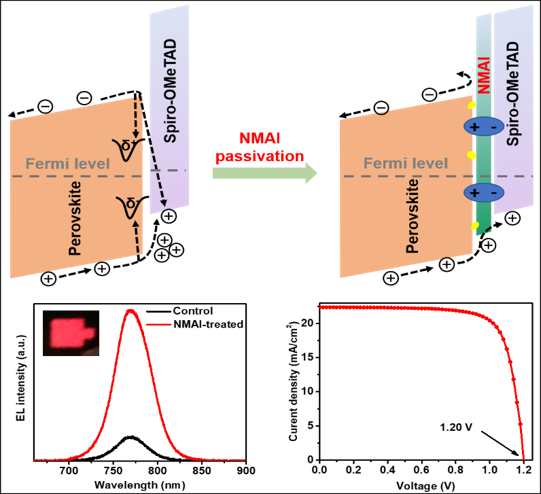Passivation is an effective method to reduce defects and inhibit non-radiative recombination. Organic amine salts such as phenethylamine iodide (PEAI) have been successfully used to passivate the perovskite surface, achieving world-record efficiency of the device for the improved VOC.
However, PEAI-treated perovskites are sensitive to temperature. At high temperatures, PEAI will react with pristine three-dimensional(3D) perovskite to form 2D perovskite, which affects the stability of the device. In addition, more work should be done to further explore the passivation mechanism of ammonium salts.
In a recent study published by Adv. Energy Mater., a research group led by Prof. GAO Peng from Fujian Institute of Research on the Structure of Matter, Chinese Academy of Sciences, reported a bulky amine approach to develop efficient perovskite solar cells by reducing interface-mediated recombination.
The researchers used a unique, bulky 1-naphthylmethylamine iodide (NMAI) for the post-treatment of CsFAMA triple-cation 3D perovskite film to passivate the perovskite surface/interface, and thereby reduce the non-radiative recombination of devices.
They found that different from PEAI, NMAI post-treatment remains almost NMAI salt itself on the surface of perovskite film rather than transformed into low-dimentional perovskites even under high thermal annealing temperature (100 °C), which was supported by density functional theory (DFT) calculation and X-ray diffraction (XRD) measurement.
Although the researchers had adopted NMAI to construct quasi-2D/3D perovskite through one-step preparation method for highly efficient perovskite light-emitting diode(LED), this dielectric ammonium salt could not only efficiently decrease the defect-assisted recombination owing to chemical passivation, but also retard the charge accumulation by inducing energy level bending and prevent minority carrier recombination due to charge-blocking.
The NMAI-treated devices showed much more intensified electroluminescence, which is direct evidence that NMAI treatment substantially suppresses the non-radiative recombination at the surface/interface of perovskite in the complete devices.
Besides, the researchers achieved a PCE of 21.04% for the triple-action PSC, a maximum VOC up to 1.20 V, and enhanced stability maintaining 98.9% of their initial efficiency after 3240 h.
This study provides new insights into the passivation mechanisms of organic ammonium salts and suggests future guidelines for developing improved passivation layers.

 Schematic illustration of the surface/interface recombination reduction by chemical passivation (passivate the trap states δ- and/or δ+), improved energy level alignment due to interface dipoles, and repelling of electrons from HTL by NMAI(Image by Prof. GAO’s group)
Schematic illustration of the surface/interface recombination reduction by chemical passivation (passivate the trap states δ- and/or δ+), improved energy level alignment due to interface dipoles, and repelling of electrons from HTL by NMAI(Image by Prof. GAO’s group)
Contact:
Prof. GAO Peng
Fujian Institute of Research on the Structure of Matter
Chinese Academy of Sciences
Email: peng.gao@fjirsm.ac.cn